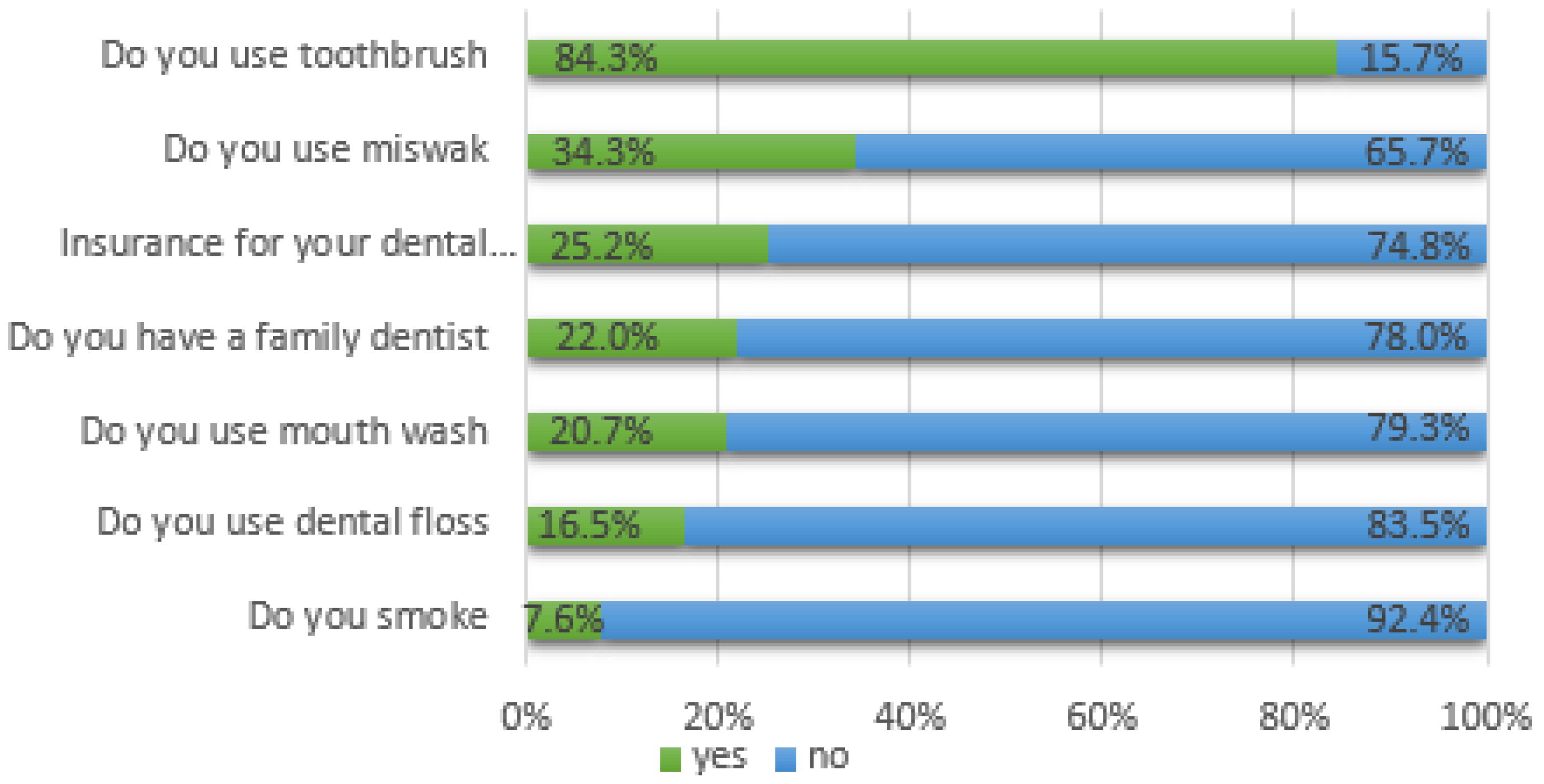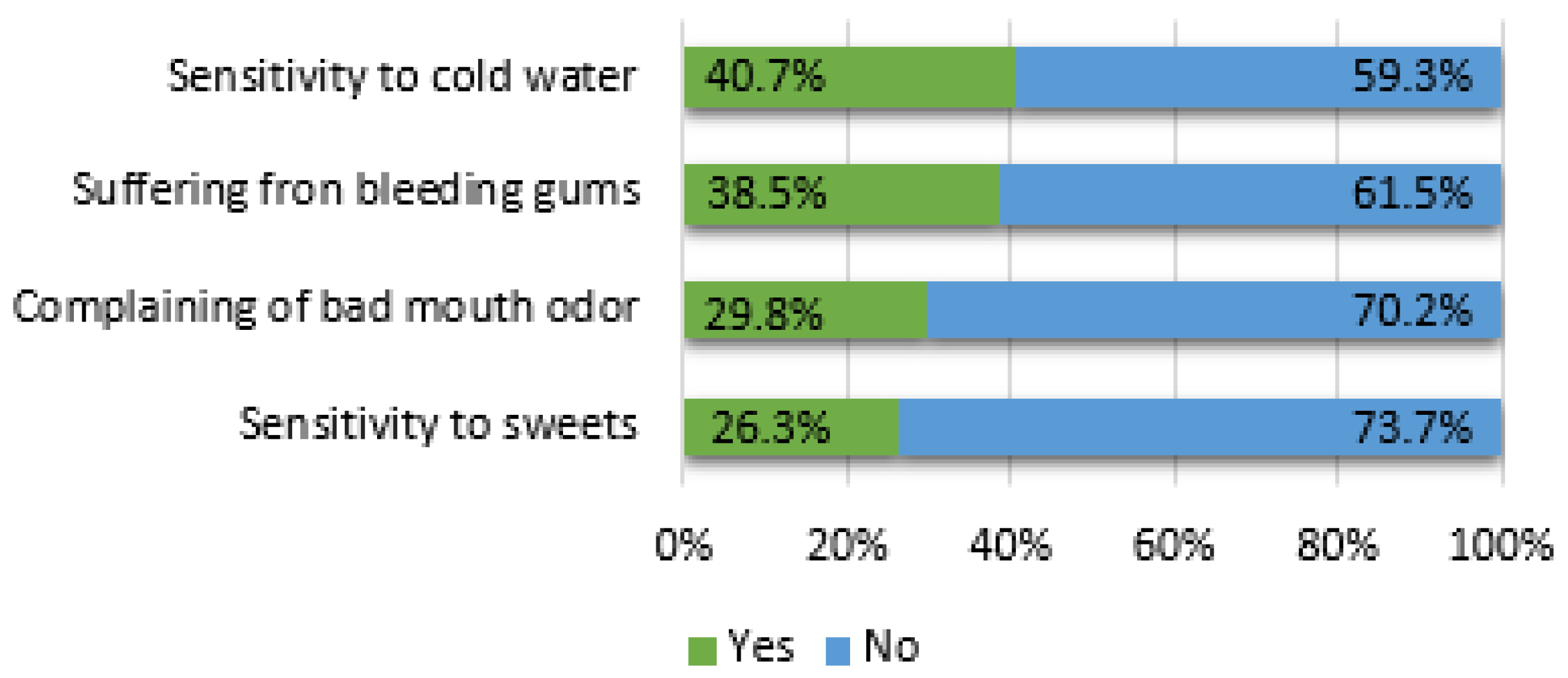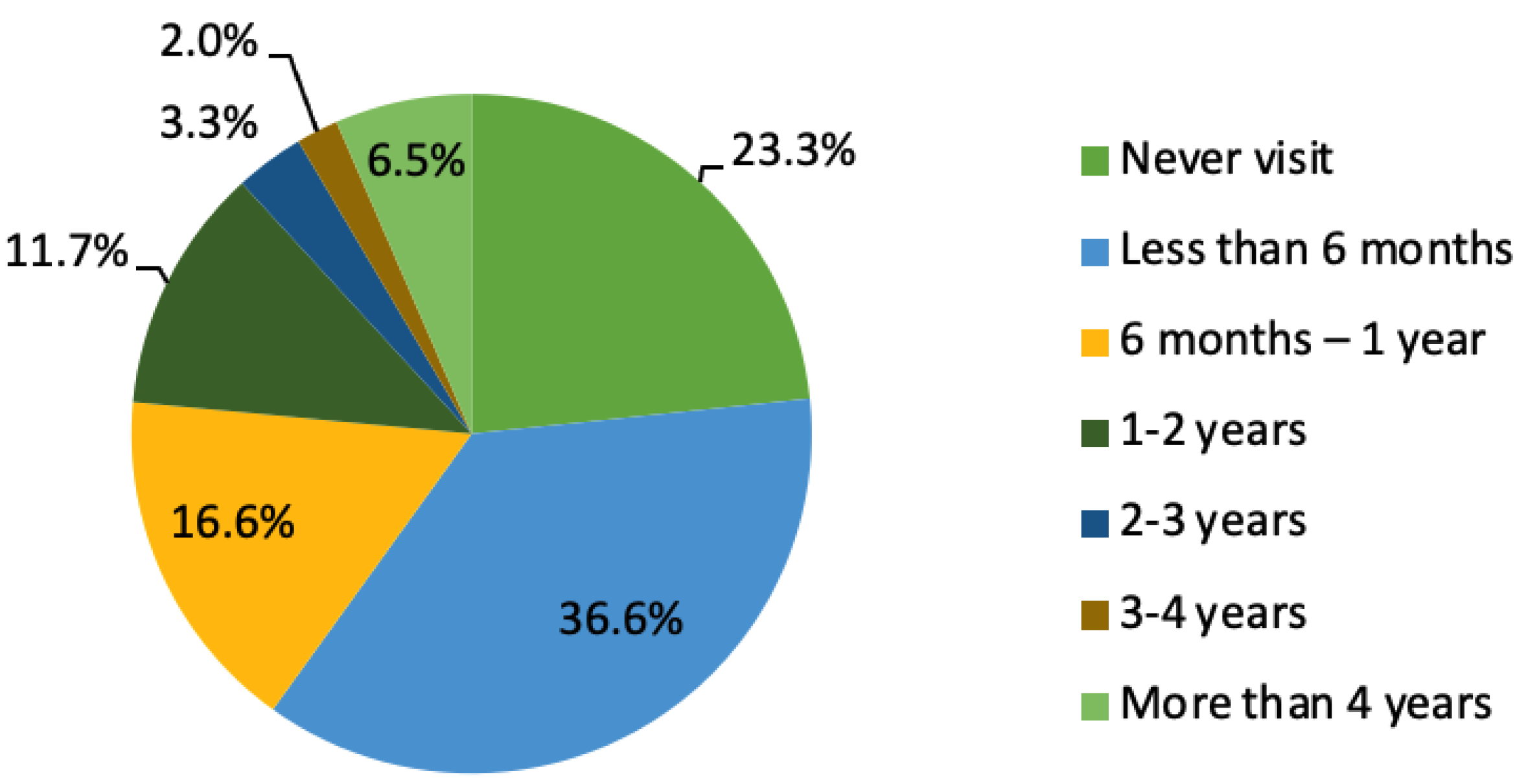Awareness and Practice of Oral Health Measures in Medina, Saudi Arabia: An Observational Study
Abstract
1. Introduction
2. Materials and Methods
2.1. Materials
2.2. Data Analysis
3. Results
4. Discussion
5. Conclusions
Author Contributions
Funding
Conflicts of Interest
Appendix A
| Characteristics | Do You Use Toothbrush | p-Value | |
|---|---|---|---|
| Yes | No | ||
| Age group | 0.051 | ||
| 4–9 (n = 124) | 100 (80.6%) | 24 (19.4%) | |
| 10–17 (n = 155) | 124 (80.0%) | 31 (20.0%) | |
| 18–30 (n = 88) | 79 (89.8%) | 9 (10.2%) | |
| 31–44 (n = 60) | 56 (93.3%) | 4 (6.7%) | |
| 45–72 (n = 33) | 29 (87.9%) | 4 (12.1%) | |
| Gender | 0.001 | ||
| Male (n = 284) | 227 (79.9%) | 57 (20.1%) | |
| Female (n = 176) | 161 (91.5%) | 15 (8.5%) | |
| Nationality | 0.015 | ||
| Saudi (n = 310) | 253 (81.6%) | 57 (18.4%) | |
| Non-Saudi (n = 150) | 133 (88.7%) | 17 (11.3%) | |
| Occupation | 0.032 | ||
| Student/preschool (n = 318) | 258 (81.1%) | 60 (18.9%) | |
| Employee (n = 75) | 71 (94.6%) | 4 (4.6%) | |
| Health care employee (n = 62) | 62 (100.0%) | 0 (0.0%) | |
| Retired (n = 5) | 3 (60%) | 2 (40%) | |
| Education | 0.001 | ||
| Preschool (n = 44) | 30 (68.2%) | 14 (31.8%) | |
| School (n = 323) | 271 (83.9%) | 52 (16.1%) | |
| Diploma (n = 27) | 23 (85.2%) | 4 (14.8%) | |
| Bachelor (n = 54) | 53 (98.1%) | 1 (1.9%) | |
| Postgrad (n = 12) | 11 (91.7%) | 1 (8.3%) | |
| Marital status | 0.001 | ||
| Single (n = 350) | 289 (82.6%) | 61 (17.4%) | |
| Married/previously married (n = 110) | 99 (90%) | 11 (10%) | |
| Smoking | 0.163 | ||
| Yes (n = 35) | 27 (77.1%) | 8 (22.9%) | |
| No (n = 425) | 361 (84.9%) | 64 (15.1%) | |
| Have dental insurance | 0.001 | ||
| Yes (n = 116) | 109 (94.0%) | 7 (6.0%) | |
| No (n = 344) | 279 (81.1%) | 65 (18.9%) | |
| Have bleeding gums | 0.104 | ||
| Yes (n = 177) | 144 (81.4%) | 33 (18.6%) | |
| No (n = 283) | 244 (86.2%) | 39 (13.8%) | |
| Have halitosis | 0.473 | ||
| Yes (n = 137) | 113 (82.5%) | 24 (17.5%) | |
| No (n = 323) | 275 (85.1%) | 48 (14.9%) | |
| Characteristics | Do You Use Tobacco | p-Value | |
|---|---|---|---|
| Yes | No | ||
| Age group | 0.000 | ||
| 4–9 (n = 124) | 0 (0.0%) | 124 (100.0%) | |
| 10–17 (n = 155) | 3 (1.9%) | 152 (98.1%) | |
| 18–30 (n = 88) | 16 (18.2%) | 72 (81.8%) | |
| 31–44 (n = 60) | 12 (20.0%) | 48 (80.0%) | |
| 45–72 (n = 33) | 4 (12.1%) | 29 (87.9%) | |
| Gender | 0.220 | ||
| Male (n = 284) | 25 (8.8%) | 259 (91.2%) | |
| Female (n = 176) | 10 (5.7%) | 166 (94.3%) | |
| Nationality | 0.907 | ||
| Saudi (n = 310) | 24 (7.7%) | 286 (92.3%) | |
| Non-Saudi (n = 150) | 11 (7.4%) | 137 (92.6%) | |
| Occupation | 0.001 | ||
| Student (n = 318) | 12 (3.8%) | 306 (96.2%) | |
| Employee (n = 75) | 24 (32%) | 51 (68%) | |
| Retired (n = 5) | 0 (0.0%) | 5 (100.0%) | |
| Health care worker (n = 62) | 8 (12.9%) | 54 (87.1%) | |
| Education | 0.002 | ||
| Preschool (n = 44) | 0 (0.0%) | 44 (100.0%) | |
| School (n = 323) | 20 (6.2%) | 303 (93.8%) | |
| Diploma (n = 27) | 3 (12.0%) | 24 (88.0%) | |
| Bachelor (n = 54) | 9 (11.2%) | 45 (88.8%) | |
| Postgrad (n = 12) | 3 (25.0%) | 9 (75.0%) | |
| Marital status | 0.001 | ||
| Single (n = 355) | 19 (5.4%) | 336 (94.6%) | |
| Married/previously married (n = 105) | 16 (15.2%) | 89 (84.8%) | |
| Have children | 0.000 | ||
| No (n = 358) | 19 (5.3%) | 339 (94.7%) | |
| Yes (n = 102) | 16 (15.7%) | 86 (84.3%) | |
| Have dental insurance | 0.944 | ||
| Yes (n = 116) | 9 (7.8%) | 107 (92.2%) | |
| No (n = 344) | 26 (7.6%) | 318 (92.4%) | |
| Have bleeding gums | 0.046 | ||
| Yes (n = 177) | 19 (10.7%) | 158 (89.3%) | |
| No (n = 283) | 16 (5.7%) | 267 (94.3%) | |
| Have halitosis | 0.032 | ||
| Yes (n = 137) | 16 (11.7%) | 121 (88.3%) | |
| No (n = 323) | 19 (5.9%) | 304 (94.1%) | |
References
- Skorupka, W.; Żurek, K.; Kokot, T.; Nowakowska-Zajdel, E.; Fatyga, E.; Niedworok, E.; Muc-Wierzgoń, M. Assessment of Oral Hygiene in Adults. Central Eur. J. Public Health 2012, 20, 233–236. [Google Scholar] [CrossRef]
- Mohtasham, G.; Mostafa, N.; Sakineh, R.; Ali, R. Unacceptable status of oral and dental health-related knowledge among Iranian primary school students. Biosci. Biotechnol. Res. Commun. 2017, 10, 260–266. [Google Scholar]
- Prpić, J.; Kuiš, D.; Glažar, I.; Ribarić, S.P. Association of Obesity with Periodontitis, Tooth Loss and Oral Hygiene in Non-smoking Adults. Central Eur. J. Public Health 2013, 21, 196–201. [Google Scholar] [CrossRef]
- Haugejorden, O.; Klock, K.S.; Åstrøm, A.N.; Skaret, E.; Trovik, T.A. Socio-economic inequality in the self-reported number of natural teeth among Norwegian adults–an analytical study. Community Dent. Oral Epidemiol. 2008, 36, 269–278. [Google Scholar] [CrossRef] [PubMed]
- Abe, M.; Mitani, A.; Yao, A.; Takeshima, H.; Zong, L.; Hoshi, K.; Yanagimoto, S. Close Associations of Gum Bleeding with Systemic Diseases in Late Adolescence. Int. J. Environ. Res. Public Health 2020, 17, 4290. [Google Scholar] [CrossRef] [PubMed]
- Chang, Y.; Woo, H.G.; Lee, J.S.; Song, T.-J. Better oral hygiene is associated with lower risk of stroke. J. Periodontol. 2020. [Google Scholar] [CrossRef]
- Nwizu, N.; Wactawski-Wende, J.; Genco, R.J. Periodontal disease and cancer: Epidemiologic studies and possible mechanisms. Periodontology 2020, 83, 213–233. [Google Scholar] [CrossRef] [PubMed]
- Peltzer, K.; Pengpid, S. Oral Health Behaviour and Social and Health Factors in University Students from 26 Low, Middle and High Income Countries. Int. J. Environ. Res. Public Health 2014, 11, 12247–12260. [Google Scholar] [CrossRef]
- Zimmermann, H.; Zimmermann, N.; Hagenfeld, D.; Veile, A.; Kim, T.-S.; Becher, H. Is frequency of tooth brushing a risk factor for periodontitis? A systematic review and meta-analysis. Community Dent. Oral Epidemiol. 2015, 43, 116–127. [Google Scholar] [CrossRef]
- Moynihan, P. The role of diet and nutrition in the etiology and prevention of oral diseases. Bull. World Health Organ. 2005, 83, 694–699. [Google Scholar]
- Isola, G. Current Evidence of Natural Agents in Oral and Periodontal Health. Nutrients 2020, 12, 585. [Google Scholar] [CrossRef] [PubMed]
- Obeidat, S.R.; Alsa’Di, A.G.; Taani, D.S. Factors influencing dental care access in Jordanian adults. BMC Oral Health 2014, 14, 1–7. [Google Scholar] [CrossRef] [PubMed]
- Ueno, M.; Ohara, S.; Inoue, M.; Tsugane, S.; Kawaguchi, Y. Association between education level and dentition status in Japanese adults: Japan public health center-based oral health study. Community Dent. Oral Epidemiol. 2012, 40, 481–487. [Google Scholar] [CrossRef] [PubMed]
- Tanner, T.; Päkkilä, J.; Karjalainen, K.; Kämppi, A.; Jarvelin, M.-R.; Patinen, P.; Tjäderhane, L.; Anttonen, V. Smoking, alcohol use, socioeconomic background and oral health among young Finnish adults. Community Dent. Oral Epidemiol. 2015, 43, 406–414. [Google Scholar] [CrossRef]
- Dar-Odeh, N.S.; Abu-Hammad, O.A. Narghile smoking and its adverse health consequences: A literature review. Br. Dent. J. 2009, 206, 571–573. [Google Scholar] [CrossRef] [PubMed]
- Dar-Odeh, N.; Bakri, F.G.; Al-Omiri, M.K.; Al-Mashni, H.M.; Eimar, H.A.; Alkhraisat, M.-H.; Abuhammad, S.; Dudeen, A.-A.F.; Abdallah, M.; Alkilani, S.M.Z.; et al. Narghile (water pipe) smoking among university students in Jordan: Prevalence, pattern and beliefs. Harm Reduct. J. 2010, 7, 10. [Google Scholar] [CrossRef]
- Dar-Odeh, N.; Abu-Hammad, O.A. The changing trends in tobacco smoking for young Arab women; narghile, an old habit with a liberal attitude. Harm Reduct. J. 2011, 8, 24. [Google Scholar] [CrossRef]
- Baboor, A.S.; A Alnazzawi, A.; Abu-Hammad, O.A.; Dar-Odeh, N. Unconventional materials and substances used in water pipe (narghile) by smokers in central western region of Saudi Arabia. Saudi Med. J. 2014, 35, 890–893. [Google Scholar]
- Tanner, T.; Kämppi, A.; Päkkilä, J.; Jarvelin, M.-R.; Patinen, P.; Tjäderhane, L.; Anttonen, V. Association of smoking and snuffing with dental caries occurrence in a young male population in Finland: A cross-sectional study. Acta Odontol. Scand. 2014, 72, 1017–1024. [Google Scholar] [CrossRef]
- Al-Shammari, K.F.; Moussa, M.A.; Al-Ansari, J.M.; Al-Duwairy, Y.S.; Honkala, E.J. Dental patient awareness of smoking effects on oral health: Comparison of smokers and non-smokers. J. Dent. 2006, 34, 173–178. [Google Scholar] [CrossRef]
- Johnson, G.K.; Hill, M. Cigarette Smoking and the Periodontal Patient. J. Periodontol. 2004, 75, 196–209. [Google Scholar] [CrossRef] [PubMed]
- Ahmad, M.S.; Bhayat, A.; Al-Samadani, K.H.; Abuong, Z. Oral health knowledge and practice among administrative staff at Taibah university, Madina, KSA. Eur. J. Gen. Dent. 2013, 2, 308. [Google Scholar] [CrossRef]
- Bhayat, A.; Ahmad, M. Oral health status of 12-year-old male schoolchildren in Medina, Saudi Arabia. East. Mediterr. Health J. 2014, 20, 732–737. [Google Scholar] [CrossRef] [PubMed]
- Ahmad, M.; Al-Samadani, K.; Bakeer, H.; Elanbya, M.O. Oral health knowledge and practice among 9-12-year-old schoolchildren in the region of Madinah, Saudi Arabia, and its impact on the prevalence of dental caries. Eur. J. Gen. Dent. 2017, 6, 54. [Google Scholar] [CrossRef]
- Al-Oufi, A.A.; Omar, O.M. Oral Health Knowledge and Practices of Mothers toward Their Children’s Oral Health in Al Madinah. Br. J. Med. Med. Res. 2016, 15, 1–10. [Google Scholar] [CrossRef]
- Dar-Odeh, N.S.; Aleithan, F.A.; Alnazzawi, A.A.; Al-Shayyab, M.H.; Abu-Hammad, S.O.; Abu-Hammad, O.A. Factors affecting oral health determinants in female university students: A cross-sectional survey in Saudi Arabia. Int. J. Adolesc. Med. Health 2017, 32. [Google Scholar] [CrossRef] [PubMed]
- Al-Otaibi, M.; Angmar-Månsson, B. Oral hygiene habits and oral health awareness among urban Saudi Arabians. Oral Health Prev. Dent. 2004, 2, 389–396. [Google Scholar]
- Madan, C.; Arora, K.; Chadha, V.S.; Manjunath, B.C.; Chandrashekar, B.R.; Moorthy, V.R.R. A knowledge, attitude, and practices study regarding dental floss among dentists in India. J. Indian Soc. Periodontol. 2014, 18, 361–368. [Google Scholar] [CrossRef]
- Yao, K.; Yao, Y.; Shen, X.; Lu, C.; Guo, Q. Assessment of the oral health behavior, knowledge and status among dental and medical undergraduate students: A cross-sectional study. BMC Oral Health 2019, 19, 26. [Google Scholar] [CrossRef]
- Abhary, M.; Al-Hazmi, A.-A. Antibacterial activity of Miswak (Salvadora persica L.) extracts on oral hygiene. J. Taibah Univ. Sci. 2016, 10, 513–520. [Google Scholar] [CrossRef]
- Noumi, E.; Snoussi, M.; Hajlaoui, H.; Valentin, E.; Bakhrouf, A. Antifungal properties of Salvadora persica and Juglans regia L. extracts against oral Candida strains. Eur. J. Clin. Microbiol. Infect. Dis. 2009, 29, 81–88. [Google Scholar] [CrossRef] [PubMed]
- Chawla, H.S. A new natural source for topical fluoride. J. Indian Dent. Assoc. 1983, 55, 419–422. [Google Scholar] [PubMed]
- Ezmirly, S.T.; Cheng, J.C.; Wilson, S.R. Saudi Arabian Medicinal Plants: Salvadora persica1 2. Planta Medica 2009, 35, 191–192. [Google Scholar] [CrossRef] [PubMed]
- Farsi, J.; Farghaly, M.; Farsi, N. Oral health knowledge, attitude and behaviour among Saudi school students in Jeddah city. J. Dent. 2004, 32, 47–53. [Google Scholar] [CrossRef] [PubMed]
- Rajab, L.D.; Petersen, P.P.E.; Bakaeen, G.; Hamdan, M.A. Oral health behaviour of schoolchildren and parents in Jordan. Int. J. Paediatr. Dent. 2002, 12, 168–176. [Google Scholar] [CrossRef] [PubMed]
- Smyth, R.S.D.; Amlani, M.; Fulton, A.; Sharif, M.O. The availability and characteristics of patient-focused YouTube videos related to oral hygiene instruction. Br. Dent. J. 2020, 228, 773–781. [Google Scholar] [CrossRef]
- Halawany, H.S.; Alhussainan, N.S.; Alghanem, A.S.; Farrash, F.A.; Al-Maflehi, N. An Assessment of the awareness and satisfaction concerning dental insurance among employee in Riyadh, Kingdom of Saudi Arabia. Pak. Oral Dent. J. 2011, 31, 401–408. [Google Scholar]
- Bassiony, M.M. Smoking in Saudi Arabia. Saudi Med. J. 2009, 30, 876–881. [Google Scholar]
- Hersch, J. Gender, Income Levels, and the Demand for Cigarettes. J. Risk Uncertain. 2013, 21, 263–282. [Google Scholar] [CrossRef]
- Scully, C.; Greenman, J. Halitosis (breath odor). Periodontology 2008, 48, 66–75. [Google Scholar] [CrossRef]
- De Geest, S.; Laleman, I.; Teughels, W.; DeKeyser, C.; Quirynen, M. Periodontal diseases as a source of halitosis: A review of the evidence and treatment approaches for dentists and dental hygienists. Periodontology 2016, 71, 213–227. [Google Scholar] [CrossRef] [PubMed]



| Characteristics Mean ± SD | (n) | (%) |
|---|---|---|
| Age group (19.0 ± 13.7 years) | ||
| 4–9 (6.8 ± 1.6) | 124 | 27.0 |
| 10–17 (12.4 ± 2.1) | 155 | 33.7 |
| 18–30 (23.6 ± 3.8) | 88 | 19.1 |
| 31–44 (35.9 ± 3.9) | 60 | 13.0 |
| 45–72 (52.5 ± 7.3) | 33 | 7.2 |
| Gender | ||
| Male | 284 | 61.7 |
| female | 176 | 38.3 |
| Nationality | ||
| Saudi | 310 | 67.4 |
| Non-Saudi | 150 | 32.6 |
| Occupation | ||
| Student or preschool | 318 | 69.1 |
| Employee | 75 | 16.3 |
| Retired | 5 | 1.1 |
| Health care employee | 62 | 13.5 |
| Education degree | ||
| Pre-school | 44 | 9.6 |
| Primary school | 201 | 43.7 |
| Intermediate school | 60 | 13.0 |
| High school | 62 | 13.5 |
| Diploma | 27 | 5.9 |
| Bachelors | 54 | 11.7 |
| Postgraduate | 12 | 2.6 |
| Marital status | ||
| Single | 350 | 76.1 |
| Married | 105 | 22.8 |
| Divorced | 2 | 0.4 |
| Widow(er) | 3 | 0.7 |
Publisher’s Note: MDPI stays neutral with regard to jurisdictional claims in published maps and institutional affiliations. |
© 2020 by the authors. Licensee MDPI, Basel, Switzerland. This article is an open access article distributed under the terms and conditions of the Creative Commons Attribution (CC BY) license (http://creativecommons.org/licenses/by/4.0/).
Share and Cite
Saadaldina, S.A.; Eldwakhly, E.; Alnazzawi, A.A.; Alharbi, R.A.; Alghamdi, B.K.; Abu Hammad, O.A.; Soliman, M. Awareness and Practice of Oral Health Measures in Medina, Saudi Arabia: An Observational Study. Int. J. Environ. Res. Public Health 2020, 17, 9112. https://doi.org/10.3390/ijerph17239112
Saadaldina SA, Eldwakhly E, Alnazzawi AA, Alharbi RA, Alghamdi BK, Abu Hammad OA, Soliman M. Awareness and Practice of Oral Health Measures in Medina, Saudi Arabia: An Observational Study. International Journal of Environmental Research and Public Health. 2020; 17(23):9112. https://doi.org/10.3390/ijerph17239112
Chicago/Turabian StyleSaadaldina, Selma A, Elzahraa Eldwakhly, Ahmad A Alnazzawi, Rayan A Alharbi, Bushra K Alghamdi, Osama A Abu Hammad, and Mai Soliman. 2020. "Awareness and Practice of Oral Health Measures in Medina, Saudi Arabia: An Observational Study" International Journal of Environmental Research and Public Health 17, no. 23: 9112. https://doi.org/10.3390/ijerph17239112
APA StyleSaadaldina, S. A., Eldwakhly, E., Alnazzawi, A. A., Alharbi, R. A., Alghamdi, B. K., Abu Hammad, O. A., & Soliman, M. (2020). Awareness and Practice of Oral Health Measures in Medina, Saudi Arabia: An Observational Study. International Journal of Environmental Research and Public Health, 17(23), 9112. https://doi.org/10.3390/ijerph17239112





